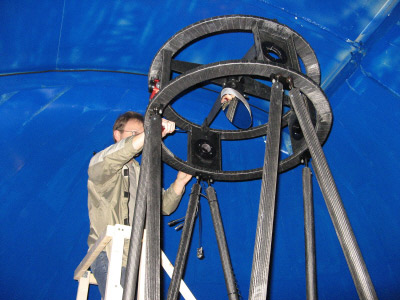.

|
| Alluna Optics delivers 60-cm
optics to Austrian observatory
Which amateur astronomer does not dream of his own observatory away from the lights of big cities. For Richard Gierlinger from Schärding in Upper Austria, this dream has come true. The preconditions were good. Richard Gierlinger has been designing and manufacturing large mounts as well as controls for telescopes for many years. The observatory is built on top of a hill without disturbing light sources and away from roads. The 5.5 meter dome houses the main instrument that can be remotely controlled from the ground floor. The annex building was rebuilt as a workshop. The location is ideal for astronomical observations. On one side the magnificent panorama of the Alps, on the other the view from the top of the 10km distant Schärding.
Unfortunately, that night with limited vision due to a full moon causing a bright sky background, only a few objects could be visually observed. Despite a full moon, the Ring Nebula in the constellation Lyra showed numerous contours. The globular cluster M13 was resolved to the centre as well as M92 in the immediate vicinity. In the future, the Newton Telescope
will be used, in addition to visual observation, particularly in CCD photography
and the tracking of minor planets and comets.
Pictures

For more information about the observatory
http://www.gierlinger.cc
|
. |
| . |
|
©2019
Alluna Optics Germany .
. |
 All
that was missing was the primary mirror for the main instrument; a 24 inch
parabolic mirror with a focal length of 2828 mm. For the contract to produce
a high-precision parabolic mirror for Richard Gierlinger, Alluna Optics
was the company of choice. In April, the order was placed. The mirror was
finished and coated with a layer of aluminium by mid-September. Wolfram
Felber (Alluna Optics) took it upon himself to deliver the parabolic mirror
in person and to visit the observatory. Due to the good preparatory work
the mirror was easily placed in the special 27-point main mirror frame
and attached to the lower end of the open tube largely consisting of carboxylic.
After a short adjustment of the focuser, secondary mirror and the main
mirror the first starlight could already be captured. The excellent measurement
values ??from the laboratory of lambda 1/10PV wavefront (distance between
the highest and the lowest point of the surface profile) and a Strehl ratio
of .98 were confirmed.
All
that was missing was the primary mirror for the main instrument; a 24 inch
parabolic mirror with a focal length of 2828 mm. For the contract to produce
a high-precision parabolic mirror for Richard Gierlinger, Alluna Optics
was the company of choice. In April, the order was placed. The mirror was
finished and coated with a layer of aluminium by mid-September. Wolfram
Felber (Alluna Optics) took it upon himself to deliver the parabolic mirror
in person and to visit the observatory. Due to the good preparatory work
the mirror was easily placed in the special 27-point main mirror frame
and attached to the lower end of the open tube largely consisting of carboxylic.
After a short adjustment of the focuser, secondary mirror and the main
mirror the first starlight could already be captured. The excellent measurement
values ??from the laboratory of lambda 1/10PV wavefront (distance between
the highest and the lowest point of the surface profile) and a Strehl ratio
of .98 were confirmed.


